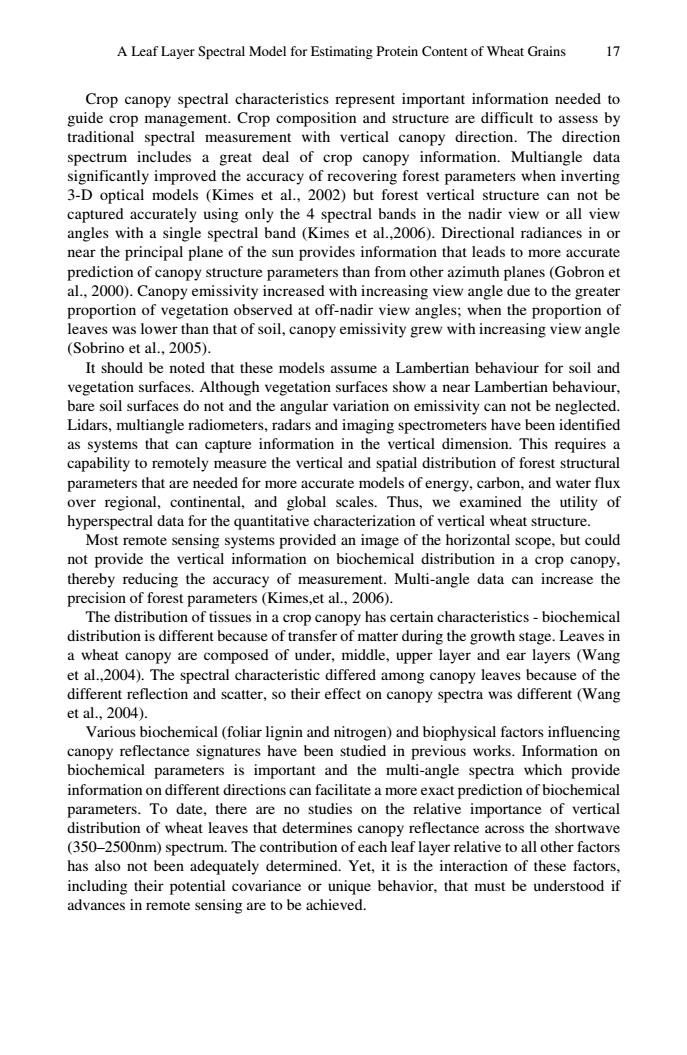正在加载图片...

A Leaf Layer Spectral Model for Estimating Protein Content of Wheat Grains 17 Crop canopy spectral characteristics represent important info rmation needed to guide crop management.Crop composition and structure are difficult to assess by traditional spectral measurement with vertical canopy direction.The direction spectrum includes a great deal of crop canopy information.Multiangle data significantly improved the accuracy of recovering forest parameters when inverting 3-D optical models (Kimes et al.,2002)but forest vertical structure can not be accurately using angles with the 4 spect nde in the nadi vie all viev a singl band (Kimes ).Directi nal radiances in o near the principal plane of the sun provides informati on that leads to more accurate prediction of canopy structure parameters than from other azimuth planes(Gobron et al.,2000).Canopy emissivity increased with increasing view angle due to the greater proportion of vegetation observed at off-nadir view angles;when the proportion of leaves was lower than that of soil,canopy emissivity grew with increasing view angle (Sobrino et al 2005). It should be noted these models assume a Lambertian behaviour for soil and vegetation st Although vegetation surfaces show a near Lambertian behaviour bare soil surfaces do not and the angular variation on emissivity can not be neglected Lidars,multiangle radiometers,radars and imaging spectrometers have been identified as systems that can capture information in the vertical dimension.This requires a capability to remotely measure the vertical and spatial distribution of forest structural parameters that are needed for more accurate models of energy,carbon.and water flux ntal,and lobal scales.Thus. the utility of vertical w ea t structure note ser ing systems provided age o f the honzonta Iscope,but could not provide the vertical information on biochemical distribution in a crop canopy. thereby reducing the accuracy of measurement.Multi-angle data can increase the precision of forest parameters(Kimes,et al.,2006). The distribution of tissues in a crop canopy has certain characteristics-biochemical distribution is different because of transfer of matter during the growth stage.Leaves in a whe nopy are nder middle,upper layer nd layers(Wan et al.2004).The spectral characteristic differed among canopy leaves because of th different reflection and scatter,so their effect on canopy spectra was different (Wang etal.2004)】 Various biochemical (foliar lignin and nitrogen)and biophysical factors influencing canopy reflectance signatures have been studied in previous works.Information on biochemical paramete ers is important and the multi-angle spectra which provide informationo d directi ons can faci act pre parameters. there are n studies on the relative importar of vertica stribution of wheat leaves that determines canopy reflectance across the shortwave (350-2500nm)spectrum.The contribution of each leaf layer relative to all other factors has also not been adequately determined.Yet,it is the interaction of these factors. including their potential covariance or unique behavior,that must be understood if advances in remote sensing are to be achieved.A Leaf Layer Spectral Model for Estimating Protein Content of Wheat Grains 17 Crop canopy spectral characteristics represent important information needed to guide crop management. Crop composition and structure are difficult to assess by traditional spectral measurement with vertical canopy direction. The direction spectrum includes a great deal of crop canopy information. Multiangle data significantly improved the accuracy of recovering forest parameters when inverting 3-D optical models (Kimes et al., 2002) but forest vertical structure can not be captured accurately using only the 4 spectral bands in the nadir view or all view angles with a single spectral band (Kimes et al.,2006). Directional radiances in or near the principal plane of the sun provides information that leads to more accurate prediction of canopy structure parameters than from other azimuth planes (Gobron et al., 2000). Canopy emissivity increased with increasing view angle due to the greater proportion of vegetation observed at off-nadir view angles; when the proportion of leaves was lower than that of soil, canopy emissivity grew with increasing view angle (Sobrino et al., 2005). It should be noted that these models assume a Lambertian behaviour for soil and vegetation surfaces. Although vegetation surfaces show a near Lambertian behaviour, bare soil surfaces do not and the angular variation on emissivity can not be neglected. Lidars, multiangle radiometers, radars and imaging spectrometers have been identified as systems that can capture information in the vertical dimension. This requires a capability to remotely measure the vertical and spatial distribution of forest structural parameters that are needed for more accurate models of energy, carbon, and water flux over regional, continental, and global scales. Thus, we examined the utility of hyperspectral data for the quantitative characterization of vertical wheat structure. Most remote sensing systems provided an image of the horizontal scope, but could not provide the vertical information on biochemical distribution in a crop canopy, thereby reducing the accuracy of measurement. Multi-angle data can increase the precision of forest parameters (Kimes,et al., 2006). The distribution of tissues in a crop canopy has certain characteristics - biochemical distribution is different because of transfer of matter during the growth stage. Leaves in a wheat canopy are composed of under, middle, upper layer and ear layers (Wang et al.,2004). The spectral characteristic differed among canopy leaves because of the different reflection and scatter, so their effect on canopy spectra was different (Wang et al., 2004). Various biochemical (foliar lignin and nitrogen) and biophysical factors influencing canopy reflectance signatures have been studied in previous works. Information on biochemical parameters is important and the multi-angle spectra which provide information on different directions can facilitate a more exact prediction of biochemical parameters. To date, there are no studies on the relative importance of vertical distribution of wheat leaves that determines canopy reflectance across the shortwave (350–2500nm) spectrum. The contribution of each leaf layer relative to all other factors has also not been adequately determined. Yet, it is the interaction of these factors, including their potential covariance or unique behavior, that must be understood if advances in remote sensing are to be achieved